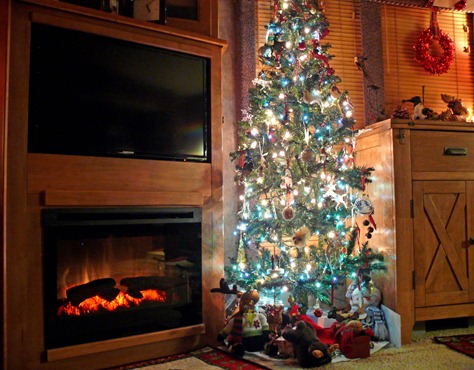This is the travel diary of Keith and Brenda Krejci, who since November 2005 have lived in their motorhome and traveled the country. When first married, Brenda would ask Keith a question, and if he didn't know the answer, would tell him "I married you because I thought you were perfect", to which Keith would reply "I never said I was perfect, just damn near" And so, after 53+ years together they've become, at least for each other, the Damn Near Perfect Couple.
Sunday, December 23, 2012
Wednesday, December 19, 2012
It’s a Ferry Nice Way to Travel
It’s hard to believe that almost a month has passed since my last blog – where does the time go? Brenda and I have been enjoying the Pacific Northwest and it’s beauty, although the weather is starting to get a bit depressing. Even though we’re in the “rain shadow” of the Olympic Mountains, we still get the overcast, dreary days. We’ve avoided any of the severe weather that the Pacific storms have brought, and so far, we’ve had no freezing temperatures.
As we learned when we lived here many years ago, you just have to dress in layers and continue to do the things you enjoy. We’ve been out visiting number of the small towns in the area, and some are beautifully decorated for the holidays. One of our favorites is Port Gamble, a small waterfront community where the well-maintained homes and shops make you think of a New England seaport.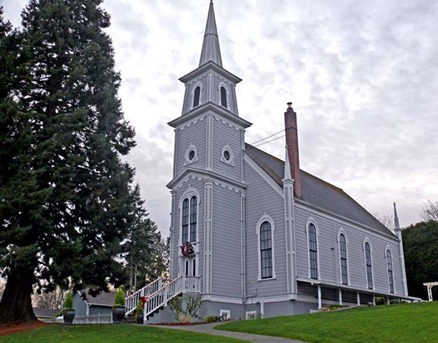 There’s a simple yet beautiful church, neatly maintained small homes, and a general store with a bit of everything, including an upside-down Christmas Tree. We visited on a weekend day when there were hayrides, vendors of crafts and food, and plenty of gaily-decorated shops to explore.
There’s a simple yet beautiful church, neatly maintained small homes, and a general store with a bit of everything, including an upside-down Christmas Tree. We visited on a weekend day when there were hayrides, vendors of crafts and food, and plenty of gaily-decorated shops to explore.
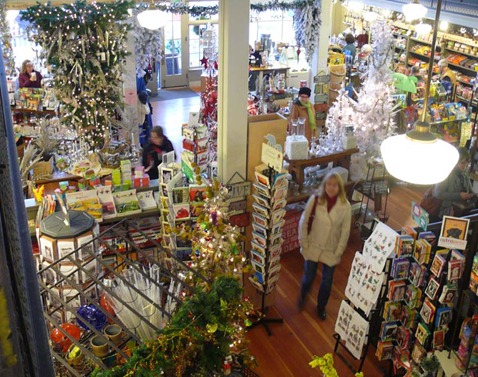
We’ve found that Washington State Ferries are an easy way to travel across Puget Sound. In this area, so many people live on the islands and peninsulas which may only be a short distance to their work or shopping as the crow flies, but can be a hundred miles by road. Ferries provide an easy, sometimes reasonable alternative to the long drive.
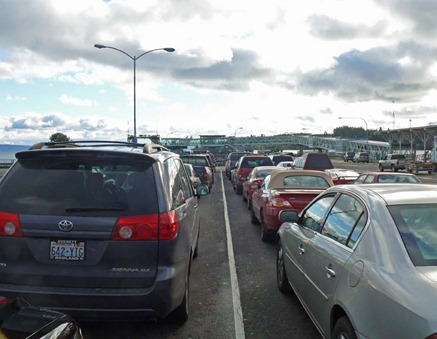 We started our ferry journey at the Kingston, WA dock, where
We started our ferry journey at the Kingston, WA dock, where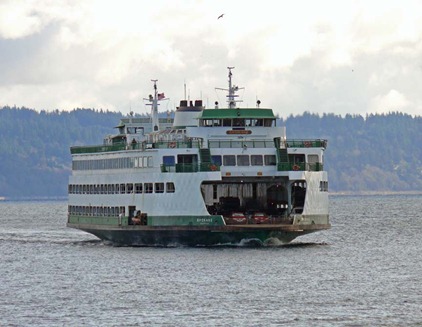 we paid our fee ($8.80 for the two of us plus the car) and we were then directed into lane 3 of
we paid our fee ($8.80 for the two of us plus the car) and we were then directed into lane 3 of 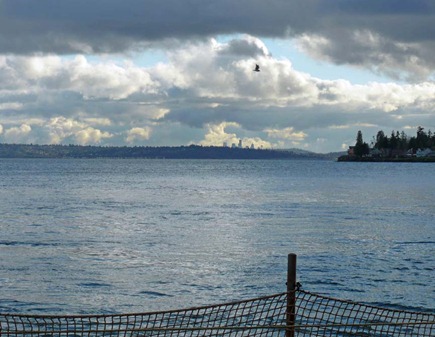 the holding area, a large parking lot . We got out and
the holding area, a large parking lot . We got out and 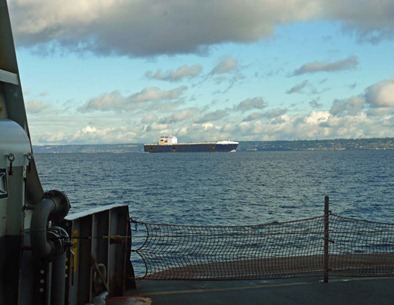 walked to a viewing area where we could see our ferry, the “Spokane” coming across Puget Sound to our dock. Once it had docked and unloaded, we were directed , two lanes at a time, into the ferry, and then into separate lanes. We were at the front of the ferry with a good view, so we decided not to leave our car for the upper deck with it’s snack bar and warm interior. Off in the distance, the skyline of Seattle was just visible, and as we began crossing, a large ship crossed our path. The trip lasted about 30 minutes, and we began to dock at Edmonds. It was interesting watching how the ferry slowed and maneuvered, and how the large ramp was lowered onto the deck of the ferry. Once docked, it doesn’t take long to unload – total time from boarding to driving off the ferry was about 45 minutes. Driving distance to get to the same location from Kingston – 108 miles, including navigating downtown Seattle. Thanks, Washington State Ferry System!
walked to a viewing area where we could see our ferry, the “Spokane” coming across Puget Sound to our dock. Once it had docked and unloaded, we were directed , two lanes at a time, into the ferry, and then into separate lanes. We were at the front of the ferry with a good view, so we decided not to leave our car for the upper deck with it’s snack bar and warm interior. Off in the distance, the skyline of Seattle was just visible, and as we began crossing, a large ship crossed our path. The trip lasted about 30 minutes, and we began to dock at Edmonds. It was interesting watching how the ferry slowed and maneuvered, and how the large ramp was lowered onto the deck of the ferry. Once docked, it doesn’t take long to unload – total time from boarding to driving off the ferry was about 45 minutes. Driving distance to get to the same location from Kingston – 108 miles, including navigating downtown Seattle. Thanks, Washington State Ferry System!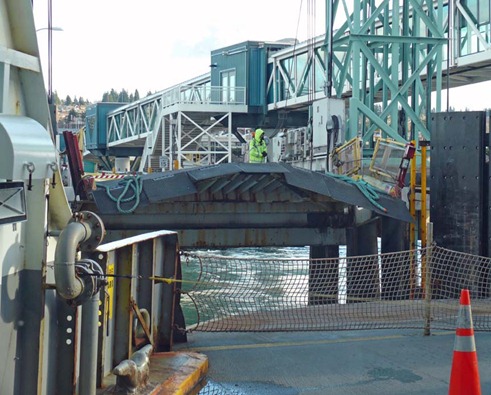
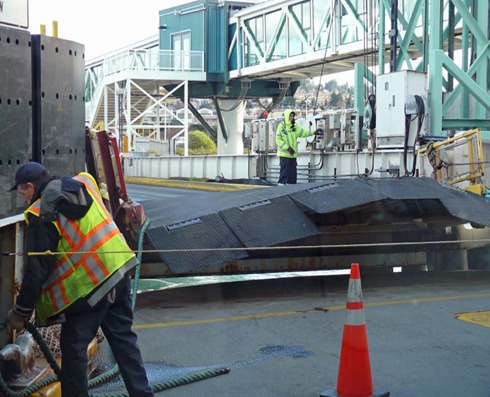
Although it’s generally overcast, every once in a while the clouds clear and we’re left with stunning views. This view across the Puget Sound of Mount Baker is one of those invigorating experiences that will carry us through another week or so of dreariness….
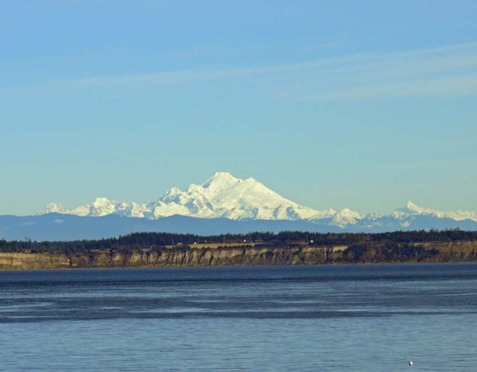
That’s it for now, we’ll be back with another update soon!
As we learned when we lived here many years ago, you just have to dress in layers and continue to do the things you enjoy. We’ve been out visiting number of the small towns in the area, and some are beautifully decorated for the holidays. One of our favorites is Port Gamble, a small waterfront community where the well-maintained homes and shops make you think of a New England seaport.
 There’s a simple yet beautiful church, neatly maintained small homes, and a general store with a bit of everything, including an upside-down Christmas Tree. We visited on a weekend day when there were hayrides, vendors of crafts and food, and plenty of gaily-decorated shops to explore.
There’s a simple yet beautiful church, neatly maintained small homes, and a general store with a bit of everything, including an upside-down Christmas Tree. We visited on a weekend day when there were hayrides, vendors of crafts and food, and plenty of gaily-decorated shops to explore. 
We’ve found that Washington State Ferries are an easy way to travel across Puget Sound. In this area, so many people live on the islands and peninsulas which may only be a short distance to their work or shopping as the crow flies, but can be a hundred miles by road. Ferries provide an easy, sometimes reasonable alternative to the long drive.
 We started our ferry journey at the Kingston, WA dock, where
We started our ferry journey at the Kingston, WA dock, where we paid our fee ($8.80 for the two of us plus the car) and we were then directed into lane 3 of
we paid our fee ($8.80 for the two of us plus the car) and we were then directed into lane 3 of  the holding area, a large parking lot . We got out and
the holding area, a large parking lot . We got out and  walked to a viewing area where we could see our ferry, the “Spokane” coming across Puget Sound to our dock. Once it had docked and unloaded, we were directed , two lanes at a time, into the ferry, and then into separate lanes. We were at the front of the ferry with a good view, so we decided not to leave our car for the upper deck with it’s snack bar and warm interior. Off in the distance, the skyline of Seattle was just visible, and as we began crossing, a large ship crossed our path. The trip lasted about 30 minutes, and we began to dock at Edmonds. It was interesting watching how the ferry slowed and maneuvered, and how the large ramp was lowered onto the deck of the ferry. Once docked, it doesn’t take long to unload – total time from boarding to driving off the ferry was about 45 minutes. Driving distance to get to the same location from Kingston – 108 miles, including navigating downtown Seattle. Thanks, Washington State Ferry System!
walked to a viewing area where we could see our ferry, the “Spokane” coming across Puget Sound to our dock. Once it had docked and unloaded, we were directed , two lanes at a time, into the ferry, and then into separate lanes. We were at the front of the ferry with a good view, so we decided not to leave our car for the upper deck with it’s snack bar and warm interior. Off in the distance, the skyline of Seattle was just visible, and as we began crossing, a large ship crossed our path. The trip lasted about 30 minutes, and we began to dock at Edmonds. It was interesting watching how the ferry slowed and maneuvered, and how the large ramp was lowered onto the deck of the ferry. Once docked, it doesn’t take long to unload – total time from boarding to driving off the ferry was about 45 minutes. Driving distance to get to the same location from Kingston – 108 miles, including navigating downtown Seattle. Thanks, Washington State Ferry System!

Although it’s generally overcast, every once in a while the clouds clear and we’re left with stunning views. This view across the Puget Sound of Mount Baker is one of those invigorating experiences that will carry us through another week or so of dreariness….

That’s it for now, we’ll be back with another update soon!
Saturday, November 24, 2012
Another Volunteer Adventure
We’ve begun our three-month volunteer adventure at the Coastal Artillery Museum located on beautiful Fort Worden State Park in Port Townsend, WA. This year we decided to do something different; instead of heading south to Texas or Arizona, we decided to head north to the Olympic Peninsula. We’ve always enjoyed the Pacific Northwest, and this is a great place to spend the winter. Port Townsend is located 25 miles from Sequim, and is in the famous “rain shadow” of the Olympic Mountains that keeps the bulk of the winter rain away (we hope). It’s a neat town and bills itself as one of only three “Victorian” seaports in the country. We’ll post pictures of this interesting place in a later blog, but for now we’ll tell you about the http://www.parks.wa.gov/fortworden/interpretive.aspx
Fort Worden is an extensive state park with most of it’s original 1900-era buildings intact – in fact the Officer’s housing, NCO housing, and some of the barracks have been restored and are rented to people visiting the area. The fort was originally built in 1902 for coastal defense, and was the main fort in the “triangle of death” – the three forts (Worden, Casey, and Flagler)that guarded the entrance to Puget Sound with it’s many shipyards. Immense concrete gun batteries were built along the top of “Artillery Hill”, the highest point on the peninsula, and although the guns are no longer there, the structures still remain. For us, we’re taking care of the museum, which displays the history of the Fort and of it’s activities during WWI, WWII, and the period afterward.
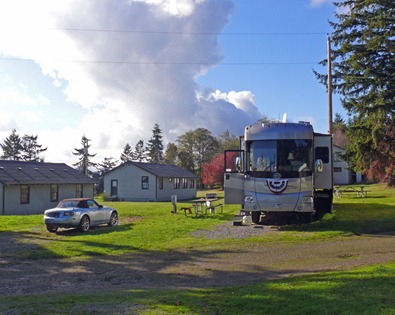 On our arrival, we were guided up the hill to the volunteer RV spots. The trip was an adventure, taking us over broken asphalt, sharp turns, and through a deep hole caused by a broken water main, where we
On our arrival, we were guided up the hill to the volunteer RV spots. The trip was an adventure, taking us over broken asphalt, sharp turns, and through a deep hole caused by a broken water main, where we 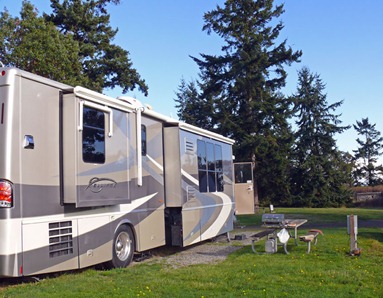 left one torn-off mud flap. Finally parked, we set up on our home for the next three months – a grassy area with a view of the water in the distance and plenty of Black-tailed deer grazing under the watchful eye or our cat.
left one torn-off mud flap. Finally parked, we set up on our home for the next three months – a grassy area with a view of the water in the distance and plenty of Black-tailed deer grazing under the watchful eye or our cat.
The museum is located in the first floor of one of the barracks that housed over 100 men, complete with a dining hall. If you look close, you can see the barred windows. The building was one of many that were used in the 1970s as a “diagnostic center” for troubled youth. Apparently not all the diagnosis went well, since the windows have bars and there are four steel-lined cells in one of the closed wings.
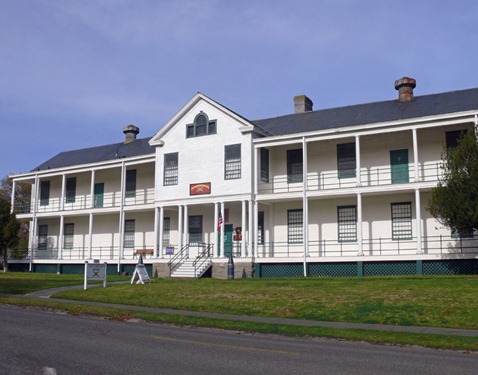
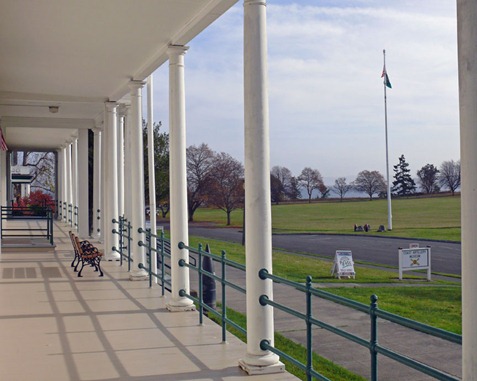
The museum has a surprisingly extensive collection of coastal artillery history, including photos, equipment, and videos. It’s a subject not well known to those who didn’t live on the East or West coast (including us), and we’ve been surprised at the immensity of the fortifications. But when you realize the need to protect the extensive shipyards in Puget Sound, you begin to understand why these forts were built. You can read about the history of the fort here.

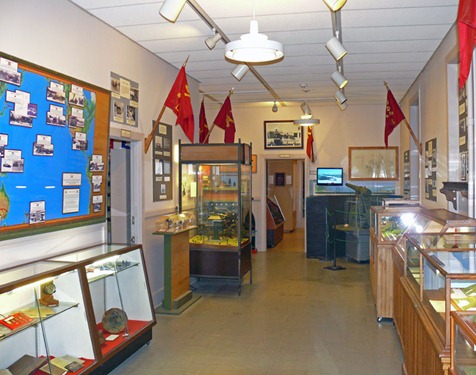
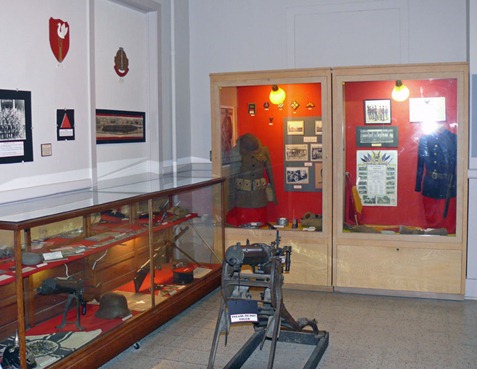
We’ll be here until the end of January and plan on spending a lot of time exploring the area – there’s a lot to see and do, so check back with us!
Fort Worden is an extensive state park with most of it’s original 1900-era buildings intact – in fact the Officer’s housing, NCO housing, and some of the barracks have been restored and are rented to people visiting the area. The fort was originally built in 1902 for coastal defense, and was the main fort in the “triangle of death” – the three forts (Worden, Casey, and Flagler)that guarded the entrance to Puget Sound with it’s many shipyards. Immense concrete gun batteries were built along the top of “Artillery Hill”, the highest point on the peninsula, and although the guns are no longer there, the structures still remain. For us, we’re taking care of the museum, which displays the history of the Fort and of it’s activities during WWI, WWII, and the period afterward.
 On our arrival, we were guided up the hill to the volunteer RV spots. The trip was an adventure, taking us over broken asphalt, sharp turns, and through a deep hole caused by a broken water main, where we
On our arrival, we were guided up the hill to the volunteer RV spots. The trip was an adventure, taking us over broken asphalt, sharp turns, and through a deep hole caused by a broken water main, where we  left one torn-off mud flap. Finally parked, we set up on our home for the next three months – a grassy area with a view of the water in the distance and plenty of Black-tailed deer grazing under the watchful eye or our cat.
left one torn-off mud flap. Finally parked, we set up on our home for the next three months – a grassy area with a view of the water in the distance and plenty of Black-tailed deer grazing under the watchful eye or our cat.The museum is located in the first floor of one of the barracks that housed over 100 men, complete with a dining hall. If you look close, you can see the barred windows. The building was one of many that were used in the 1970s as a “diagnostic center” for troubled youth. Apparently not all the diagnosis went well, since the windows have bars and there are four steel-lined cells in one of the closed wings.


The museum has a surprisingly extensive collection of coastal artillery history, including photos, equipment, and videos. It’s a subject not well known to those who didn’t live on the East or West coast (including us), and we’ve been surprised at the immensity of the fortifications. But when you realize the need to protect the extensive shipyards in Puget Sound, you begin to understand why these forts were built. You can read about the history of the fort here.



We’ll be here until the end of January and plan on spending a lot of time exploring the area – there’s a lot to see and do, so check back with us!
Thursday, November 08, 2012
Revisiting Mount St Helens
In 1980, I was a Master Sergeant air traffic controller, stationed at McChord AFB near Tacoma, WA. On Sunday morning, May 18th, I was working in the radar room below the control tower, enjoying my second or third cup of coffee, when around 8:30 there was a loud “boom” and the tower shook as if there was a nearby sonic boom. It wasn’t long before the controller in the tower yelled over the intercom “Holy #$%^& – the mountain just blew up!”. And so started my Mt. St. Helens experience.
We promptly went into a semi-confused near panic mode – after all, none of us had any experience in dealing with a cloud of volcanic ash. We’d been told that if the mountain erupted, the ash would be hard and metallic (yup, the cloud rapidly covered half my radar screen), might conduct electricity, and would probably clog and kill our car engines. Although the bulk of the ash drifted Northeast of us, it became dark and light ash began to fall. One aircraft, a four-engine turboprop cargo contract hauler, insisted on taking off in spite of our warnings. He did….and returned 20 minutes later with two engines out, one running rough, and one overheating. He managed to land in spite of the fact that his windshield was sanded opaque by the ash, and the normally painted aircraft was down to the bare metal on all of the leading edges of wings and the nose. After that, no one wanted to take off. Although most of the fears of a heavy ash fall did not materialize, it was an interesting time, and one all of us that were there will always remember.
We hadn’t visited the area around the mountain since we left McChord in 1982, so we decided to spend an extra day as we drove north. We stayed at a great RV Park in Kelso, the Brookhollow RV Park. After days of overcast skies and rain, we were happy to see the clouds start to breakup as we left the park. Our first stop was the Washington State Park visitor center at Silver Lake, not far off the interstate. It’s a beautiful facility and a good place to learn about the mountain before continuing the drive. From the parking lot, you could see the mountain in the distance as the clouds began to clear.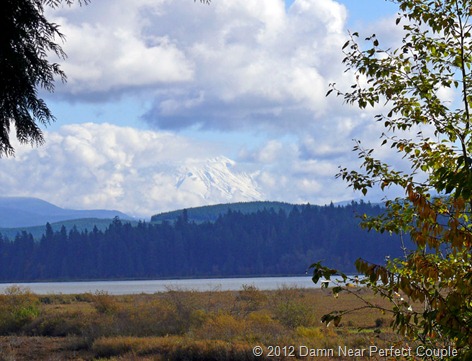
As we followed the highway along the Toutle River, we realized that the mountain was covered in a fresh coating of snow, and the clouds were slowly starting to burn off. This valley is where the huge mudflow, taking homes and roads with it, funneled down from the eruption.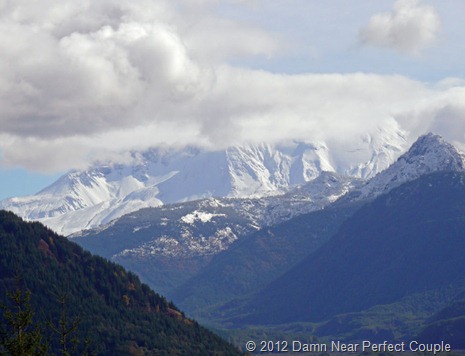
At the next viewpoint, we could begin to see the crater, still steaming as it slowly rebuilds the mountain. A previous visitor had left a “snow elf” on the railing for us!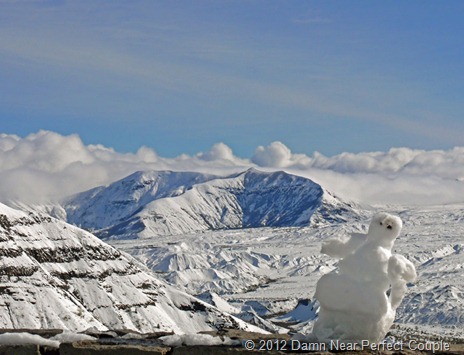
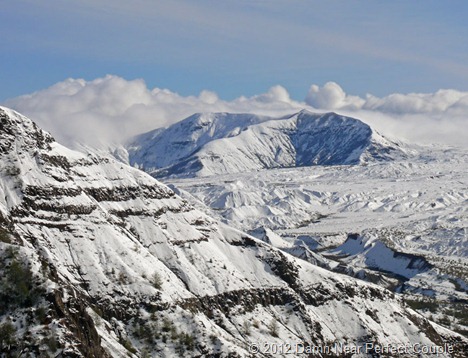
Our trip ended at the visitor center at Johnson Ridge, named for David Johnson, a volcanologist who was camped near this site and was the first to report the eruption with the radio call “Vancouver, Vancouver, this is it!” Tragically, he wasn’t scheduled to be on the mountain, but was filling in for a friend. His remains were never found. You can read about him here. From the visitor center, we had an unrestricted view of the mountain and crater, with tendrils of steam flowing from the new dome. Makes you juuuust a little bit nervous!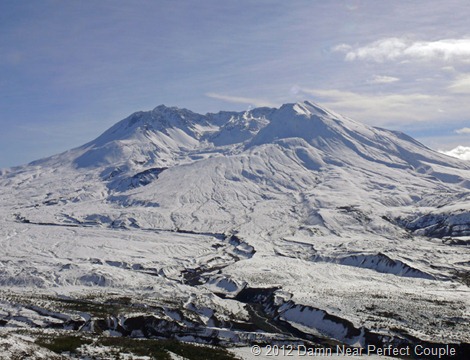
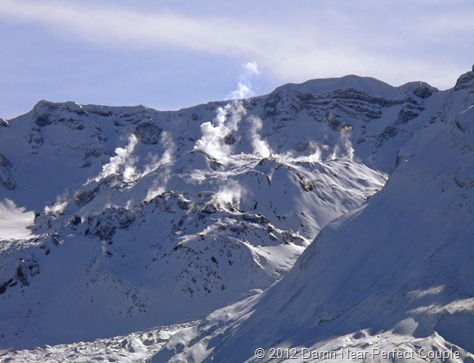
It was a fantastic weather day – except that it was cold!
From inside the visitor center, large windows provided a panoramic view, and along the walls were stories, some sad, of the rescues made after the eruption. We especially enjoyed one that told of a husband, wife, and baby being airlifted by helicopter. The woman put the baby into their backpack to keep warm, and the helicopter crew kept yelling for her to throw away the backpack. They couldn’t hear her response, and finally decided that if the backpack was so important to her, she could keep it. One of the few stories with a happy ending….
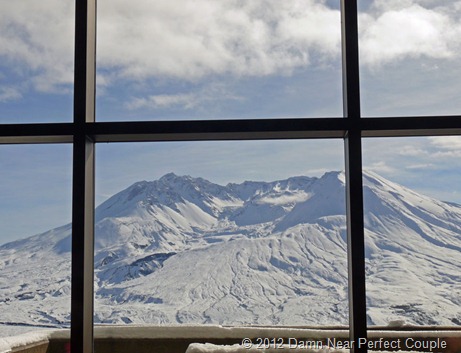
The visitor center has a large, well-appointed theater with an interesting movie about the eruption. When the movie is finished, the screen raises to reveal this: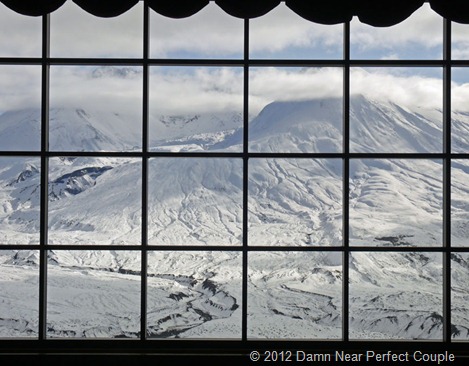
It was a fitting finale to an absolutely wonderful, memorable day. We could visit the mountain for years again and never see it like this! We’ll leave you with this panoramic photo (don’t forget to click on it to enlarge):
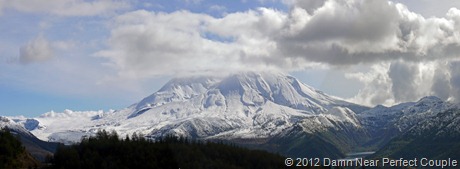
We’ll be starting our volunteer job at Fort Worden’s Coastal Artillery Museum soon, so check back and see us!
We promptly went into a semi-confused near panic mode – after all, none of us had any experience in dealing with a cloud of volcanic ash. We’d been told that if the mountain erupted, the ash would be hard and metallic (yup, the cloud rapidly covered half my radar screen), might conduct electricity, and would probably clog and kill our car engines. Although the bulk of the ash drifted Northeast of us, it became dark and light ash began to fall. One aircraft, a four-engine turboprop cargo contract hauler, insisted on taking off in spite of our warnings. He did….and returned 20 minutes later with two engines out, one running rough, and one overheating. He managed to land in spite of the fact that his windshield was sanded opaque by the ash, and the normally painted aircraft was down to the bare metal on all of the leading edges of wings and the nose. After that, no one wanted to take off. Although most of the fears of a heavy ash fall did not materialize, it was an interesting time, and one all of us that were there will always remember.
We hadn’t visited the area around the mountain since we left McChord in 1982, so we decided to spend an extra day as we drove north. We stayed at a great RV Park in Kelso, the Brookhollow RV Park. After days of overcast skies and rain, we were happy to see the clouds start to breakup as we left the park. Our first stop was the Washington State Park visitor center at Silver Lake, not far off the interstate. It’s a beautiful facility and a good place to learn about the mountain before continuing the drive. From the parking lot, you could see the mountain in the distance as the clouds began to clear.

As we followed the highway along the Toutle River, we realized that the mountain was covered in a fresh coating of snow, and the clouds were slowly starting to burn off. This valley is where the huge mudflow, taking homes and roads with it, funneled down from the eruption.

At the next viewpoint, we could begin to see the crater, still steaming as it slowly rebuilds the mountain. A previous visitor had left a “snow elf” on the railing for us!


Our trip ended at the visitor center at Johnson Ridge, named for David Johnson, a volcanologist who was camped near this site and was the first to report the eruption with the radio call “Vancouver, Vancouver, this is it!” Tragically, he wasn’t scheduled to be on the mountain, but was filling in for a friend. His remains were never found. You can read about him here. From the visitor center, we had an unrestricted view of the mountain and crater, with tendrils of steam flowing from the new dome. Makes you juuuust a little bit nervous!


It was a fantastic weather day – except that it was cold!

From inside the visitor center, large windows provided a panoramic view, and along the walls were stories, some sad, of the rescues made after the eruption. We especially enjoyed one that told of a husband, wife, and baby being airlifted by helicopter. The woman put the baby into their backpack to keep warm, and the helicopter crew kept yelling for her to throw away the backpack. They couldn’t hear her response, and finally decided that if the backpack was so important to her, she could keep it. One of the few stories with a happy ending….

The visitor center has a large, well-appointed theater with an interesting movie about the eruption. When the movie is finished, the screen raises to reveal this:

It was a fitting finale to an absolutely wonderful, memorable day. We could visit the mountain for years again and never see it like this! We’ll leave you with this panoramic photo (don’t forget to click on it to enlarge):

We’ll be starting our volunteer job at Fort Worden’s Coastal Artillery Museum soon, so check back and see us!
Sunday, October 28, 2012
Saying Goodbye to Oregon
We’ve wrapped up our stay in Oregon and are headed north into Washington. We’ve had a great stay in our almost seven months here - it’s such a beautiful state with so much more to see. We’ll miss the amazing coast, the green mountains, and tax-free shopping – but we’ll be back some day.
One of the things that full-timers enjoy most is meeting up with others on the road. Last year we volunteered at the D.C. Booth Historic Fish Hatchery in Spearfish, SD, with some wonderful folks.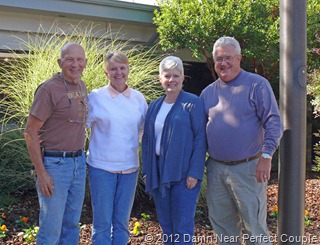 Two of these, Lee and Belinda, had finished up their volunteer duties near Portland and were headed down I-5, and so we managed to get together for a long lunch. What great folks! We had fun catching up and sharing our plans for next year, and of course making plans to meet up again.
Two of these, Lee and Belinda, had finished up their volunteer duties near Portland and were headed down I-5, and so we managed to get together for a long lunch. What great folks! We had fun catching up and sharing our plans for next year, and of course making plans to meet up again.
After leaving Myrtle Creek, we drove the short distance to Eugene and settled in at Armitage County Park for a few days. We really enjoy Eugene; it’s vibrant downtown is home to a wonderful Saturday market and it is, after all, the home of the Oregon Ducks football team. It was a gloomy and drizzly day at the market, but there was a good crowd and the vendors filled at least three square blocks. The crowd, the live music, and the colorful vegetables made it a fun morning of shopping. Looking at the peppers, I was struck by what a great jigsaw puzzle the picture would make.



After stocking up on veggies and home-baked bread, we headed east into the mountains. We’d heard about the little town of Sisters and how beautiful the area was. Our route would take us over the mountains on what quickly became a rainy day. But we pressed on, thinking that a little rain wouldn’t slow us down. Climbing into the mountains, we turned off the main road onto “scenic” route 242, one of those roads that on the map says “closed during the winter” and has signs prohibiting vehicles over 25 feet. After a short while, we could see why – curvy, narrow, and with heavy forest on both sides of the road – a perfect roadster route!
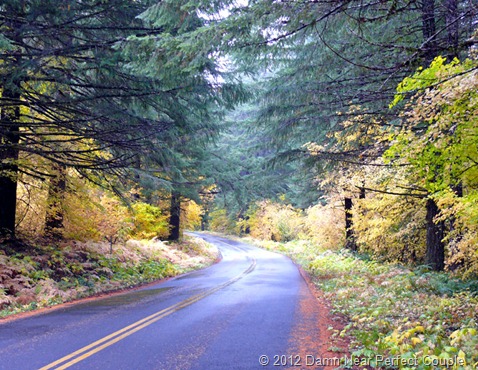
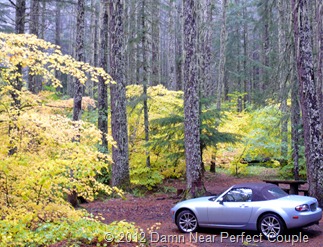 Although Oregon lacks the colorful hardwoods of the Northeast, the edge of the forest was full of golds and yellows, and the rain and mist gave everything a surreal look. It was quite a contrast between the areas along the road with the colorful trees and ferns and the dark forest on either side.
Although Oregon lacks the colorful hardwoods of the Northeast, the edge of the forest was full of golds and yellows, and the rain and mist gave everything a surreal look. It was quite a contrast between the areas along the road with the colorful trees and ferns and the dark forest on either side.
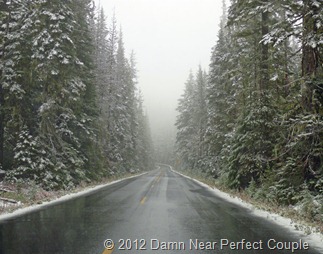 As we continued up into the mountains, the rain began to take on a different look – the drops started getting bigger, flatter, and sorta white…..which brought back dim memories of an Ohio winter. But with the confidence of someone who weathered winters in the midwest, and faith in the tread of recently purchased tires, we headed onward….and upward. It’s October right? So how bad could it get?
As we continued up into the mountains, the rain began to take on a different look – the drops started getting bigger, flatter, and sorta white…..which brought back dim memories of an Ohio winter. But with the confidence of someone who weathered winters in the midwest, and faith in the tread of recently purchased tires, we headed onward….and upward. It’s October right? So how bad could it get?
This bad:
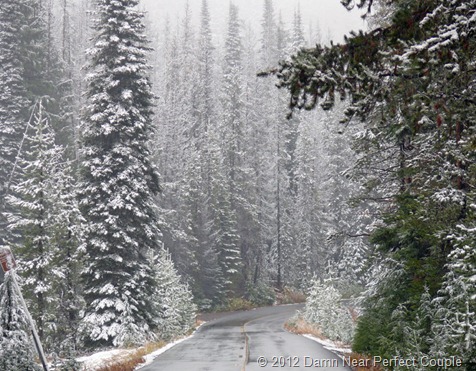
Actually, it was perfect – the trees were snow-covered but the road was only wet, and stayed that way until we began out descent into Sisters. It was breathtakingly beautiful! As we drove on it started to dry out, and by the time we arrived in town the sun was shining. Sisters was a cute little town with lots of shops specializing in quilting, and we had a nice late lunch at Bronco Billy’s, a former hotel built in the early 1900s. We headed home on a major highway; less scenic but faster and with less snow.
Finally, we ran across this sign near the RV park in Sutherlin, next to an closed gas station. Sometimes just by reading a sign you can get a sense of the frustration of the author. You have to admit, this one was candid: I think Mike stated his case in terms everyone can understand and appreciate.
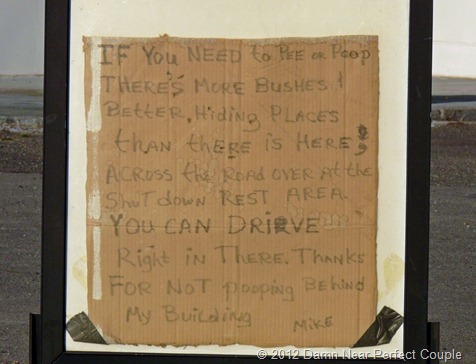
That’s it for now – check back and see where we stop along our journey!
One of the things that full-timers enjoy most is meeting up with others on the road. Last year we volunteered at the D.C. Booth Historic Fish Hatchery in Spearfish, SD, with some wonderful folks.
 Two of these, Lee and Belinda, had finished up their volunteer duties near Portland and were headed down I-5, and so we managed to get together for a long lunch. What great folks! We had fun catching up and sharing our plans for next year, and of course making plans to meet up again.
Two of these, Lee and Belinda, had finished up their volunteer duties near Portland and were headed down I-5, and so we managed to get together for a long lunch. What great folks! We had fun catching up and sharing our plans for next year, and of course making plans to meet up again.After leaving Myrtle Creek, we drove the short distance to Eugene and settled in at Armitage County Park for a few days. We really enjoy Eugene; it’s vibrant downtown is home to a wonderful Saturday market and it is, after all, the home of the Oregon Ducks football team. It was a gloomy and drizzly day at the market, but there was a good crowd and the vendors filled at least three square blocks. The crowd, the live music, and the colorful vegetables made it a fun morning of shopping. Looking at the peppers, I was struck by what a great jigsaw puzzle the picture would make.



After stocking up on veggies and home-baked bread, we headed east into the mountains. We’d heard about the little town of Sisters and how beautiful the area was. Our route would take us over the mountains on what quickly became a rainy day. But we pressed on, thinking that a little rain wouldn’t slow us down. Climbing into the mountains, we turned off the main road onto “scenic” route 242, one of those roads that on the map says “closed during the winter” and has signs prohibiting vehicles over 25 feet. After a short while, we could see why – curvy, narrow, and with heavy forest on both sides of the road – a perfect roadster route!

 Although Oregon lacks the colorful hardwoods of the Northeast, the edge of the forest was full of golds and yellows, and the rain and mist gave everything a surreal look. It was quite a contrast between the areas along the road with the colorful trees and ferns and the dark forest on either side.
Although Oregon lacks the colorful hardwoods of the Northeast, the edge of the forest was full of golds and yellows, and the rain and mist gave everything a surreal look. It was quite a contrast between the areas along the road with the colorful trees and ferns and the dark forest on either side. As we continued up into the mountains, the rain began to take on a different look – the drops started getting bigger, flatter, and sorta white…..which brought back dim memories of an Ohio winter. But with the confidence of someone who weathered winters in the midwest, and faith in the tread of recently purchased tires, we headed onward….and upward. It’s October right? So how bad could it get?
As we continued up into the mountains, the rain began to take on a different look – the drops started getting bigger, flatter, and sorta white…..which brought back dim memories of an Ohio winter. But with the confidence of someone who weathered winters in the midwest, and faith in the tread of recently purchased tires, we headed onward….and upward. It’s October right? So how bad could it get?This bad:

Actually, it was perfect – the trees were snow-covered but the road was only wet, and stayed that way until we began out descent into Sisters. It was breathtakingly beautiful! As we drove on it started to dry out, and by the time we arrived in town the sun was shining. Sisters was a cute little town with lots of shops specializing in quilting, and we had a nice late lunch at Bronco Billy’s, a former hotel built in the early 1900s. We headed home on a major highway; less scenic but faster and with less snow.
Finally, we ran across this sign near the RV park in Sutherlin, next to an closed gas station. Sometimes just by reading a sign you can get a sense of the frustration of the author. You have to admit, this one was candid: I think Mike stated his case in terms everyone can understand and appreciate.

That’s it for now – check back and see where we stop along our journey!
Friday, September 28, 2012
Day Trip to Crater Lake
We’ve spent a fair amount of time in Oregon over the last seven years of traveling, but never had the time or were within a day’s drive of Crater Lake. This time around, we’re in a location that made the visit manageable, and so on a bright sunny day, with temperatures in the mid-70s, we put the top down, topped off the tank, and headed into the Cascades for a visit to this amazing place.
We decided to make a loop to avoid backtracking, and so we left I-5 and Canyonville on highway 227 for a 100 mile drive to enter the South Gate of the park and visit the Park Headquarters and visitor center. As you get near the park, the road climbs continuously, since the walls of the crater reach high above the surrounding terrain. After a brief stop and with park map in hand, we entered the East Rim drive, again climbing to the edge of the lake. The rim drive is a road that clings to the side of the lake with steep drop-offs on, of course, the passenger side. The side with the passenger who doesn’t like to look down a thousand feet or so to what would be certain death if the driver would dare to look around at the scenery and veer off the road. Fortunately, Brenda was nice enough to remind me, in her gentle, encouraging voice to KEEP MY EYES ON THE ROAD!
Our first pull-off viewpoint was the Phantom Ship overlook, and the view was breathtaking. The smoke in the air from distant wildfires gave the lake a ghostly appearance making the Phantom Ship island look even more, well, phantomish.
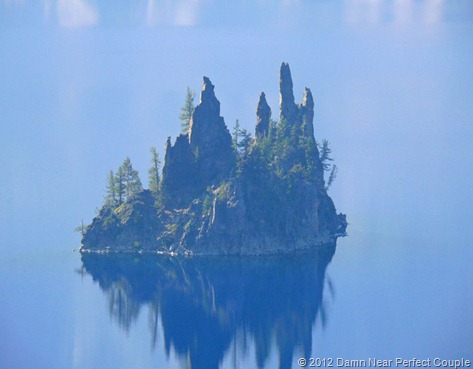 What strikes you immediately is how far the lake is below the rim, and how difficult it would be to get to the water level. There’s only one access to the water level, at the tour boat docks. According the the park literature, it’s a 1.1 mile hike, with many switchbacks, down to the water and boat dock, and coming back up, people should allow for an hour or so to make the hike, which is the equivalent of climbing 70+ flights of stairs. There is no other way to access the water, in fact, helicopters were used to place the boats in the water. I was curious when I read that there is no fishing license required, and no limits on how many and what type of fish you can catch and keep. Now I understand – instead of a license just bring 1000’ of rope and a big winch!
What strikes you immediately is how far the lake is below the rim, and how difficult it would be to get to the water level. There’s only one access to the water level, at the tour boat docks. According the the park literature, it’s a 1.1 mile hike, with many switchbacks, down to the water and boat dock, and coming back up, people should allow for an hour or so to make the hike, which is the equivalent of climbing 70+ flights of stairs. There is no other way to access the water, in fact, helicopters were used to place the boats in the water. I was curious when I read that there is no fishing license required, and no limits on how many and what type of fish you can catch and keep. Now I understand – instead of a license just bring 1000’ of rope and a big winch!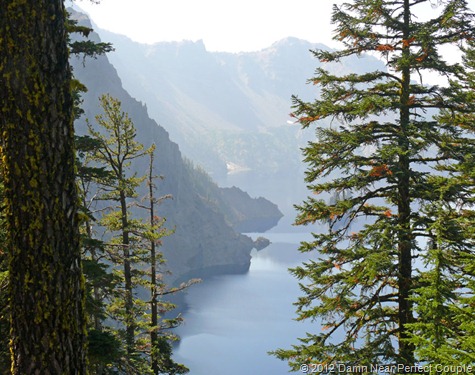
Standing at any of the overlooks, it’s easy to understand why Crater Lake is the deepest lake in the US at over 1900’, and the seventh deepest in the world. The angle of the crater walls is so steep that you can easily visualize how far down the crater floor must be. It was interesting to us that the lake is closed to any flow of water in our out; it maintains a constant level through annual rain and snowfall in the winter and evaporation in summer.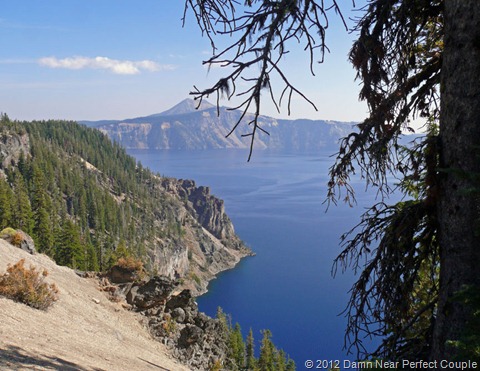
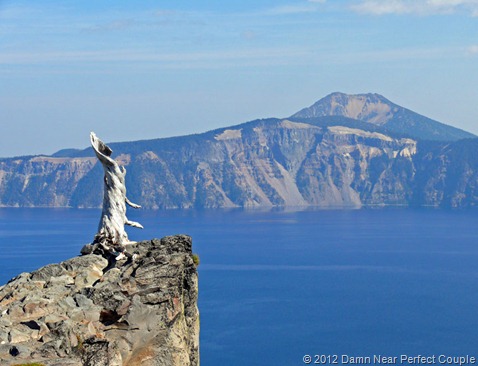
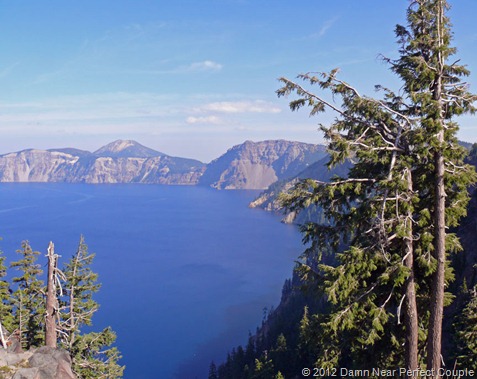 Stopping at other viewpoints along the drive, the rock walls showed the different colored layers formed by the lava, and in many areas, interesting formations like the “Castle” in the picture below.
Stopping at other viewpoints along the drive, the rock walls showed the different colored layers formed by the lava, and in many areas, interesting formations like the “Castle” in the picture below.
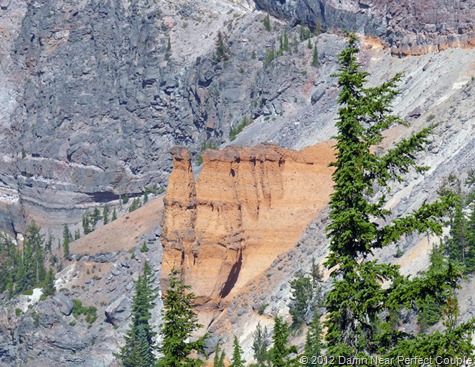
At another viewpoint, we stopped for a look a Wizard Island, the top of a volcanic cone that formed after the original volcano collapsed. It actually rises over 2700’ from the floor of the lake, but only about 750’ above the lake’s surface. From our viewpoint, it looked less like a wizard and more like a manta ray swimming away from us.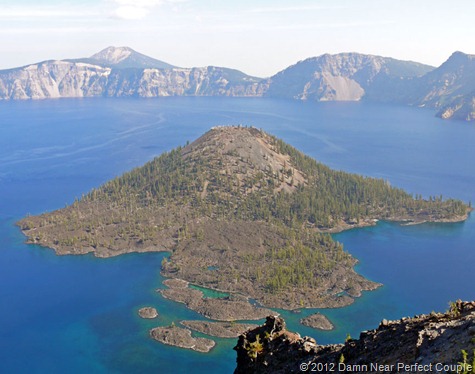
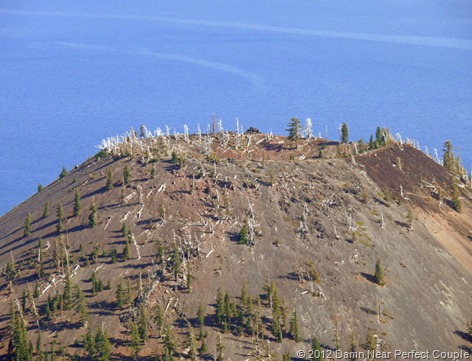 We ended our drive at Rim village, mostly closed down at this time of year. The park has a short season, opening in mid-Jun or later, and closing in October, although snowfall could make it earlier.
We ended our drive at Rim village, mostly closed down at this time of year. The park has a short season, opening in mid-Jun or later, and closing in October, although snowfall could make it earlier.
Not only is the park itself remarkable, but the surrounding area also. Large, rolling mountain meadows, forests, and distant peaks like Mount Thielson make this a truly special place.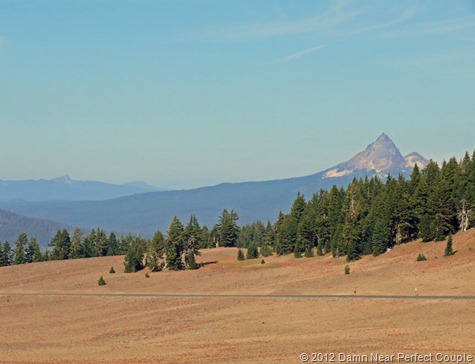
We left the park through the North entrance, on the road that was covered with eight feet or more of snow when we last visited the area in May. Back then, Mount Thielson was snow covered and Diamond Lake was completely covered in ice; now the mountain was bare and the lake was a deep blue, surrounded by trees with leaves that were beginning to change into fall colors. It won’t be long until the snow starts to fall, and the average at the lake is 533 inches – yes, that’s over 44 FEET, and when it does, it gets pretty quiet around here. We’re glad we had the opportunity to finally visit this incredible place, and hope you get the chance if you haven’t already.
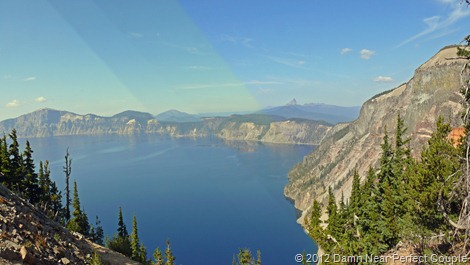
We’ve got more exploring to do, c’mon back soon!
We decided to make a loop to avoid backtracking, and so we left I-5 and Canyonville on highway 227 for a 100 mile drive to enter the South Gate of the park and visit the Park Headquarters and visitor center. As you get near the park, the road climbs continuously, since the walls of the crater reach high above the surrounding terrain. After a brief stop and with park map in hand, we entered the East Rim drive, again climbing to the edge of the lake. The rim drive is a road that clings to the side of the lake with steep drop-offs on, of course, the passenger side. The side with the passenger who doesn’t like to look down a thousand feet or so to what would be certain death if the driver would dare to look around at the scenery and veer off the road. Fortunately, Brenda was nice enough to remind me, in her gentle, encouraging voice to KEEP MY EYES ON THE ROAD!
Our first pull-off viewpoint was the Phantom Ship overlook, and the view was breathtaking. The smoke in the air from distant wildfires gave the lake a ghostly appearance making the Phantom Ship island look even more, well, phantomish.

 What strikes you immediately is how far the lake is below the rim, and how difficult it would be to get to the water level. There’s only one access to the water level, at the tour boat docks. According the the park literature, it’s a 1.1 mile hike, with many switchbacks, down to the water and boat dock, and coming back up, people should allow for an hour or so to make the hike, which is the equivalent of climbing 70+ flights of stairs. There is no other way to access the water, in fact, helicopters were used to place the boats in the water. I was curious when I read that there is no fishing license required, and no limits on how many and what type of fish you can catch and keep. Now I understand – instead of a license just bring 1000’ of rope and a big winch!
What strikes you immediately is how far the lake is below the rim, and how difficult it would be to get to the water level. There’s only one access to the water level, at the tour boat docks. According the the park literature, it’s a 1.1 mile hike, with many switchbacks, down to the water and boat dock, and coming back up, people should allow for an hour or so to make the hike, which is the equivalent of climbing 70+ flights of stairs. There is no other way to access the water, in fact, helicopters were used to place the boats in the water. I was curious when I read that there is no fishing license required, and no limits on how many and what type of fish you can catch and keep. Now I understand – instead of a license just bring 1000’ of rope and a big winch!
Standing at any of the overlooks, it’s easy to understand why Crater Lake is the deepest lake in the US at over 1900’, and the seventh deepest in the world. The angle of the crater walls is so steep that you can easily visualize how far down the crater floor must be. It was interesting to us that the lake is closed to any flow of water in our out; it maintains a constant level through annual rain and snowfall in the winter and evaporation in summer.


 Stopping at other viewpoints along the drive, the rock walls showed the different colored layers formed by the lava, and in many areas, interesting formations like the “Castle” in the picture below.
Stopping at other viewpoints along the drive, the rock walls showed the different colored layers formed by the lava, and in many areas, interesting formations like the “Castle” in the picture below.

At another viewpoint, we stopped for a look a Wizard Island, the top of a volcanic cone that formed after the original volcano collapsed. It actually rises over 2700’ from the floor of the lake, but only about 750’ above the lake’s surface. From our viewpoint, it looked less like a wizard and more like a manta ray swimming away from us.

 We ended our drive at Rim village, mostly closed down at this time of year. The park has a short season, opening in mid-Jun or later, and closing in October, although snowfall could make it earlier.
We ended our drive at Rim village, mostly closed down at this time of year. The park has a short season, opening in mid-Jun or later, and closing in October, although snowfall could make it earlier. Not only is the park itself remarkable, but the surrounding area also. Large, rolling mountain meadows, forests, and distant peaks like Mount Thielson make this a truly special place.

We left the park through the North entrance, on the road that was covered with eight feet or more of snow when we last visited the area in May. Back then, Mount Thielson was snow covered and Diamond Lake was completely covered in ice; now the mountain was bare and the lake was a deep blue, surrounded by trees with leaves that were beginning to change into fall colors. It won’t be long until the snow starts to fall, and the average at the lake is 533 inches – yes, that’s over 44 FEET, and when it does, it gets pretty quiet around here. We’re glad we had the opportunity to finally visit this incredible place, and hope you get the chance if you haven’t already.

We’ve got more exploring to do, c’mon back soon!
Friday, September 14, 2012
Riding the Rogue River
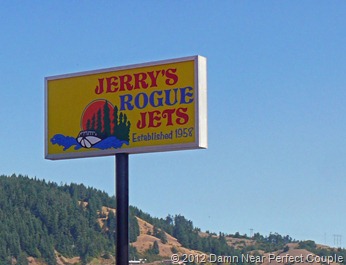 We had a few days off before leaving the coast, and decided that after three summers on the coast, it was time to take a ride on “Jerry’s Jet Boats”, a local adventure that it seems everyone we know has ridden. The history of the boats is an interesting story of how, without roads, settlers in the mountains along the Rogue River could only receive supplies and mail by mule train or boats. Over time, the need for the boats as supply vessels eroded, and the tour industry was born.
We had a few days off before leaving the coast, and decided that after three summers on the coast, it was time to take a ride on “Jerry’s Jet Boats”, a local adventure that it seems everyone we know has ridden. The history of the boats is an interesting story of how, without roads, settlers in the mountains along the Rogue River could only receive supplies and mail by mule train or boats. Over time, the need for the boats as supply vessels eroded, and the tour industry was born. 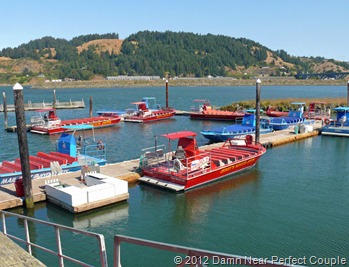 Today, Jerry’s is a big operation, with 15 boats making a number different runs each day. We opted for the 80-mile “whitewater excursion” trip over the shorter 64-mile and longer 104-mile trips. Each trip stops in Agness, where a couple of lodges provide meals and a place to relax.
Today, Jerry’s is a big operation, with 15 boats making a number different runs each day. We opted for the 80-mile “whitewater excursion” trip over the shorter 64-mile and longer 104-mile trips. Each trip stops in Agness, where a couple of lodges provide meals and a place to relax.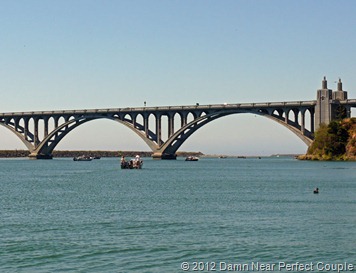 It was a chilly, but sunny and beautiful day on the coast. Since this was a weekday after the Labor Day holiday, there weren’t a lot of tourists and so we boarded one of the smaller, 32-foot long boats with about 30 other people. Leaving the harbor, we had to weave around all the fisherman in small boats trying for salmon which are beginning to show up for the fall migration. As we passed under the highway 101 bridge and headed upriver, our speed increased and the temperature began to get warmer.
It was a chilly, but sunny and beautiful day on the coast. Since this was a weekday after the Labor Day holiday, there weren’t a lot of tourists and so we boarded one of the smaller, 32-foot long boats with about 30 other people. Leaving the harbor, we had to weave around all the fisherman in small boats trying for salmon which are beginning to show up for the fall migration. As we passed under the highway 101 bridge and headed upriver, our speed increased and the temperature began to get warmer. 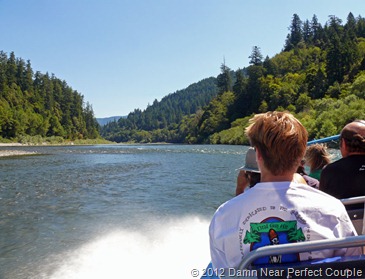 The boats really scoot – with three engines and jet drives they run at around 35 MPH but are capable of speeds over 60, and only need a foot of water or less to operate. At the first area of open water, our pilot performed a high speed whifferdill – a maneuver where the boat is put into a sharp turn, then spins on it’s nose, throwing lots of water everywhere. Fun this time, but a little less after about 20 or so.
The boats really scoot – with three engines and jet drives they run at around 35 MPH but are capable of speeds over 60, and only need a foot of water or less to operate. At the first area of open water, our pilot performed a high speed whifferdill – a maneuver where the boat is put into a sharp turn, then spins on it’s nose, throwing lots of water everywhere. Fun this time, but a little less after about 20 or so. 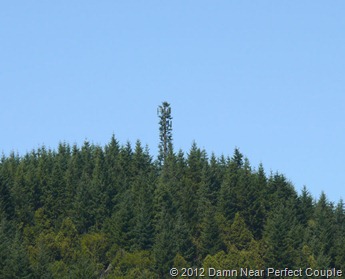 As we sped up the river, we saw lots of Common Mergansers along the shore, and in the distance, spotted a rare Oregon Cell-Pine among the trees. Surprisingly, we saw many Osprey; when we spent our summers in Montana, they had left for their winter homes in South America by now. There were a number of Bald Eagle perched in trees along the way, and even a Harbor Seal about 10 miles up river. We watched this pair of River Otter as they cruised the banks looking for food – it’s amazing how fast they can move through the water!
As we sped up the river, we saw lots of Common Mergansers along the shore, and in the distance, spotted a rare Oregon Cell-Pine among the trees. Surprisingly, we saw many Osprey; when we spent our summers in Montana, they had left for their winter homes in South America by now. There were a number of Bald Eagle perched in trees along the way, and even a Harbor Seal about 10 miles up river. We watched this pair of River Otter as they cruised the banks looking for food – it’s amazing how fast they can move through the water!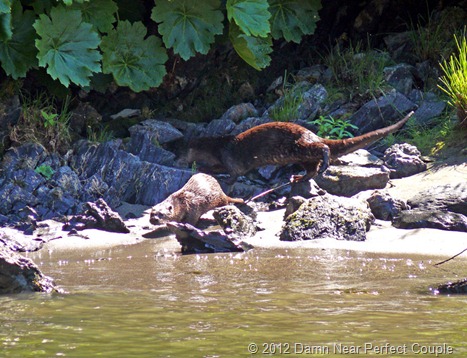
Along the way we came across this “Dinosaur Tree”, a strangely-shaped pine. The fence in front of it is electrified and placed there by the Forest Service for use by overnight campers to keep their food from the bears.
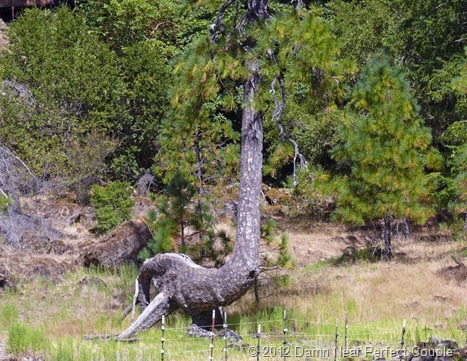
We sped past Agness and continued upriver for the “white water” portion of the trip. We were a bit disappointed, it really was more riffles than rapids, but our pilot managed to hit the water just at the right angle so that we’d be drenched in the spray. And then do another “wifferdill” just to make sure no one remained dry. After a while, we turned back around for our meal stop at the Singing Springs Lodge. After a long hike up the bluff, we enjoyed a nice buffet on the porch overlooking the water. We’d heard both good and bad about the food, but were pleased with the quality and service, although the price ($14 each) was a bit high. After the climb, the food, and the trip upriver, it was tough to stay awake on the trip back down. Except for all the damn whifferdills keeping us wet. We saw another pair of otters, and finally, the holy grail of wildlife, a black bear. It was eating blackberries in one of the many patches along the river, and seeing us, stood up, took one look, and disappeared into the woods before anyone could get a picture.
We pulled into the harbor a little over seven hours after our trip began. By now, we were back in the marine layer and temperature was hovering in the low 50s with a strong wind, and we were glad to get in the car and start home. Our impressions of the trip: Worth the cost ($70 each + meals), but not something we’d do again. Our pilot, Jon, wasn’t one of the more personable, and seemed more interested in bashing US Fish & Wildlife than telling us about the river. The scenery is very pretty, but nothing unusual, and after a while the hard seats of the boat became a real irritant. If we could do it over, we’d opt for the shorter, 64-mile trip, pack a picnic lunch, and bring along a waterproof windbreaker.
That’s it for our time on the coast! We’ve crossed the coastal range and are parked in Myrtle Creek, along the I-5 corridor. We’ll be here for a while, so check back and see what we’re doing!
Subscribe to:
Posts (Atom)
